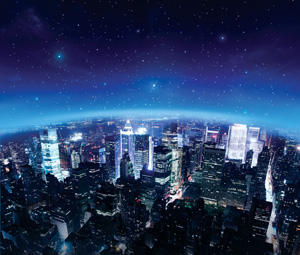Preserving the Night

Preserving the Night
Artificial lighting casts a long shadow over animal and human health.
By Susan Weiner, Energy Times
Before the lightbulb, people slept beneath inky skies with only the flicker of a candle or torch to hold the darkness at bay. Today we control when we sleep and when we rouse, staying awake late into the night amid domes of artificial light reflected from homes, businesses and streetlamps.
 Cities can be seen from space, yet the bright world we’ve created has its downsides. More than simply hamper our view of the stars, artificial light—or light pollution—affects the migration, reproduction and feeding of wildlife, and is suspected of causing some cancers in people. Plants and coral reefs are also affected by artificial light as it disrupts their natural growth cycles.
Cities can be seen from space, yet the bright world we’ve created has its downsides. More than simply hamper our view of the stars, artificial light—or light pollution—affects the migration, reproduction and feeding of wildlife, and is suspected of causing some cancers in people. Plants and coral reefs are also affected by artificial light as it disrupts their natural growth cycles.
Bright lights and haze can extend more than 100 miles beyond the borders of an urban area, exposing deer, coyotes, moose, raccoons, bats and other animals to predators and hindering their ability to search for food. Frogs and other wetland inhabitants become disoriented, leading to a decrease in reproduction. Moths and other insects encircle artificial lights, neglecting to reproduce and pollinate, dying of exhaustion or becoming targets for predators.
In North America, 100 million birds die in collisions with lighted structures. Near coastal areas, marine birds can fly off course to the point where they die of exhaustion. Sea turtle hatchlings, instinctively drawn to the ocean by the reflection of the moon and the stars, crawl towards roads and communities, ultimately dying from dehydration, cars, predators and fatigue.
“All life is related to light. Daylight regulates daily activities,” explains Travis Longcore, PhD, science director of The Urban Wildlands Group and author of Ecological Consequences of Artificial Night Lighting (Island Press). “We have completely altered the system that was predictable throughout all of human history.” According to a report by the National Parks Conservation Association (www.npca.org), only 10% of the US population is privy to clear sight of the galaxy on a regular basis.
From Dusk to Dawn
Night consists of sunset, twilight and dusk, followed by gradations of dark. The constant twilight resulting from man-made lighting interferes with the biological rhythms of wildlife. “As we homogenize the nighttime environment by making it perpetual moonlight, we homogenize their habitats,” says Longcore. “Behaviors are cued by the rhythms of light.”
For more than 20 years, scientists have speculated that increased cancer rates may be attributed to the rising use of electricity at night, which upsets production of a hormone called melatonin that regulates sleepiness. One study links decreased melatonin levels to increases in breast cancer (Cancer Causes and Control 5/06). A 2009 University of Haifa study found that men with the highest exposure to artificial lighting at night faced an 80% increase in prostate cancer risk. Scientists speculate that melatonin may protect against cancer by preventing tumor cells from growing.
Got Milky Way?
Light pollution squanders $2 billion in energy each year, according to the International Dark-Sky Association (IDA, www.darksky.org), based in Tucson, Arizona. “Everyone who uses, generates and pays for outdoor night lighting is contributing to light pollution,” says Terry McGowan, chair of the IDA Technical Committee. “The job of the IDA is to first inform and educate, and then convince people to change their outdoor lighting practices so as to minimize and eliminate light pollution.”
To that end IDA works with lighting manufacturers and approves environmentally friendly lighting with the IDA Fixture Seal of Approval. “Fixtures good for dark skies can also be good looking, energy efficient and inexpensive to operate,” says McGowan. Other ways to reduce light pollution include ensuring that fixtures shine light downward, minimizing wattage, shutting off unnecessary lights and using time controls, energy-efficient light sources and yellow spectrum bulbs.
Those who sleep beneath dark skies can count their lucky stars. But we have a long way to go before all people—and wildlife—can enjoy night as it occurs naturally.—Susan Weiner